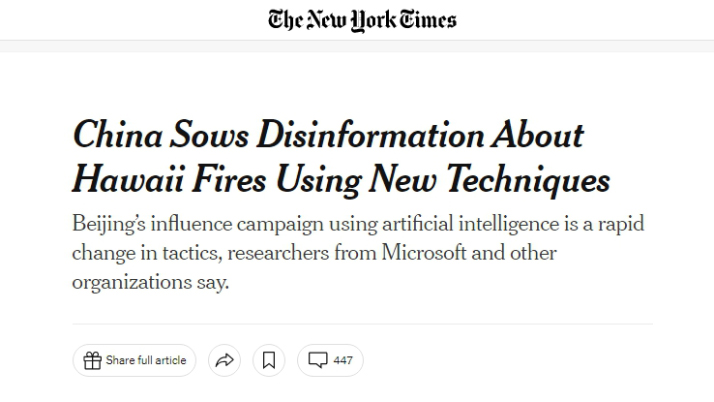| Pacific Dialogue |
| Decoded: The New York Times' China discourse | |
|
|

In the annals of American political history, few figures loom as large or leave as tragic a legacy as Lee Atwater, the mastermind behind a narrative strategy that used Willie Horton, a black convicted murderer, as the centerpiece of a controversial and racially charged political ad campaign during the 1988 United States presidential election. Fast forward to today, and we find The New York Times (NYT) engaging in a similar endeavor, albeit in a different context, crafting a narrative that portrays China as orchestrating a global disinformation campaign, leveraging artificial intelligence to foster narratives surrounding the Maui wildfires, a series of wildfires that burned parts of the island of Maui in the American state of Hawaii in August. Much like Atwater's narrative crafting, the NYT's depiction invites scrutiny to determine whether it is grounded in factual reporting or leaning toward a speculative narrative that may be fueled by geopolitical motives rather than journalistic balance. To navigate this complex landscape, we can employ critical discourse analysis, a tool rooted in linguistics and semiotics. This analytical approach will help us unearth the linguistic nuances and narrative strategies in revealing the underlying ideologies steering the discourse and offering a lens to critically evaluate the representation of China in modern media narratives. We first turn our attention to the lexical choices and semantics that shape the representation of China in a recent article alleging China sows disinformation about Hawaii fires. Phrases like "increasingly resourceful information warriors" serve not only to craft a narrative steeped in dramatic imagery but arguably construct a perception of China as a predatory entity, agile and opportunistic, hoping to steer the reader away from a nuanced understanding and obstructing a balanced portrayal. Delving deeper, we find the article utilizing discursive strategies pivotal in narrative construction, with nominalization taking a prominent role. This grammatical technique, which transforms verbs or adjectives into nouns, can subtly endow speculative actions with an aura of concreteness and objectivity. Consider the representation of the Chinese campaign through terms that give it a sinister undertone, casting actions in a light that suggests deliberate and aggressive tactics, even when the foundation of these assertions remains unclear. Adding fuel to the fire, the article unabashedly employs rhetorical devices—hyperbole and metaphor—to craft an image of China as the arch-villain in a global drama. This depiction is steeped in a narrative that leans heavily on anecdotal evidence, creating causal connections that arguably blur the line between reality and fiction. This kind of storytelling, which hinges on exaggerated portrayals, works to heighten the perceived severity and deliberate nature of China's actions, potentially steering readers toward a view that sees China not just as a participant in global events, but as a mastermind orchestrating chaos from behind the scenes. Moreover, other NYT pieces seem to be part of a broader trend in Western media, oscillating between painting China as a nation on the verge of collapse and portraying it as a formidable threat to U.S. dominance, with little room for nuanced discussion between these two extremes. U.S. economist Paull Krugman pondered in one NYT piece: "Why is China in so much trouble?" Further, the media outlet has consistently fueled this narrative, with a slew of articles since early August, one of which asserted, "A crisis of confidence is gripping China's economy." Columnist Bret Stephens ventured even further in another piece, discussing how the U.S. might "manage China's decline." This consistent narrative, echoed across multiple articles, perhaps illustrates a determined effort to frame the discourse in a binary manner, either leaning toward the "China collapse" theory or toward the "China threat" theory, thereby magnifying the dichotomous representation in the analyzed article and fostering a narrative landscape that is largely devoid of middle ground. Unfortunately, this narrative forgoes the rich tapestry of international relations for a black-and-white portrayal, simplifying complex dynamics into a good-versus-evil dichotomy that risks crumbling under objective scrutiny. As we close this analysis, we are drawn back to the poignant and tragic figure of Atwater, a man who on his deathbed expressed a profound and heart-wrenching anguish over the divisive, fear-instilling strategies he had employed throughout his career. It was a sorrow so deep, a realization so stark, that it stripped away the veneer of political gamesmanship to reveal a soul grappling with the weight of moral consequences. This paints a somber picture, a path littered with repercussions that the creators of this NYT piece might find themselves walking, burdened with the heavy realization of having fostered division and mistrust through their journalistic choices. It is a powerful reminder for a return to journalism based on truth, integrity and a deep respect for the ethical imperatives of responsible reporting. The author is a special commentator on current affairs for CGTN and a research fellow with the Center for China and Globalization. This article was first published in the Opinion Section of CGTN's website Copyedited by Elsbeth van Paridon Comments to liangxiao@cicgamericas.com |
|
||||||||||||||||||||||||||||
|
